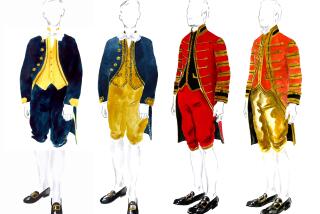Bridal Path
- Share via
Ah, the wedding cake, that elegant tower of white confection. It seems like an age-old tradition, but it’s only been on the marital scene since the mid-1800s.
That’s when finely ground white flour, baking powder and baking soda arrived on pantry shelves in the U.S. Until then, the newlyweds usually cut into a dark, spicy fruitcake.
For the matrimonially curious, historical tidbits like this are served up in a wedding exhibit at the Stagecoach Inn Museum in Newbury Park. Through September, this offering is a look at wedding traditions, clothing and accessories in vogue during the Victorian era, the flapper years in the 1920s and up to World War II.
Highlighting the display are about 20 wedding dresses, many donated or on loan from residents in the area.
“They go from the 1870s to the 1940s, and they are opulent,” said Beverly Viola, museum curator and president of the Conejo Valley Historical Society.
The fabric runs the gamut--satin, silk, embroidered batiste, ruffled organdy, organza, lace, netting. And these dresses weren’t always white. One is an elegant blue silk.
“They often wore a dress in a color and it became their best dress,” Viola said.
The Victorian wedding dresses of the late 1800s--when the Stagecoach Inn was in its heyday--are easy to spot because of their tiny waists, cinched in by corsets.
One bridal gown from about 1910 was in a style called the “hobble skirt dress.” The hemline of the skirt was pulled so snug that the bride could take only mincing steps of about 6 inches. Things loosened up considerably for the brides during the 1920s, when their dresses lacked any waistline.
Many of these gowns and wedding accessories were handed down through family members. An off-white satin dress with hundreds of tiny pleats was donated by Vada May Nelson of Camarillo. It was made by her aunt. Another lace beauty was worn by both Rosalie Udelf and then 42 years later by her daughter, Eunice Udelf, both volunteers at the museum.
One of the most elegant and historically valuable wedding accessories is a white quilt with amazingly intricate stitching that was part of the trousseau of Mary Jane Baxter Kellogg, the mother of Frances Newbury. It was donated by Suzanne Foote, the great-granddaughter of local pioneers Egbert and Frances Newbury.
The exhibit also includes a groom’s outfit, complete with embroidered suspenders and a beaver-skin top hat. Satin bridal shoes, gloves, ornate matrimonial certificates, wedding portraits and intricate needlework are part of the collection.
In the museum’s dining room, the table is set for a wedding celebration, complete with three-tiered white wedding cake, Haviland china and streamers extending from the chandelier to the table’s four corners.
But the historical tidbits about wedding traditions and styles are just as impressive. Popular turn-of-the-century wedding gifts were hand-painted and hand-cut glass and crystal, hand-painted serving dishes, butter churns, parlor lamps and vases, all according to the records of a Rochester, Minn., store.
The traditional wedding portrait didn’t appear much before 1870, perhaps because of the taboo about the bride being seen in her gown before the ceremony.
The bridal bouquet was a selection of cut flowers whose first letters spelled out the groom’s name. For instance, the woman marrying “Rob” might pick roses, orange blossoms and baby’s breath.
The young woman of those days spent years tediously hand-stitching items for her trousseau. By the time she married she had a stock of hand-hemmed delicate handkerchiefs, bed linens, chemises, and other clothing and underwear to last several years.
BE THERE
The Stagecoach Inn Museum, located at 51 S. Ventu Park Road, Newbury Park, is open Wednesday through Sunday, 1 to 4 p.m., for docent-led tours. Admission is $3 for adults, $2 for seniors, $1 for children 5-12, and free to children under 5. (805) 498-9441.
One bridal gown from about 1910 was in a style called the “hobble skirt dress.” The hemline of the skirt was pulled so snug that the bride could take only mincing steps of about 6 inches.
More to Read
Sign up for The Wild
We’ll help you find the best places to hike, bike and run, as well as the perfect silent spots for meditation and yoga.
You may occasionally receive promotional content from the Los Angeles Times.






